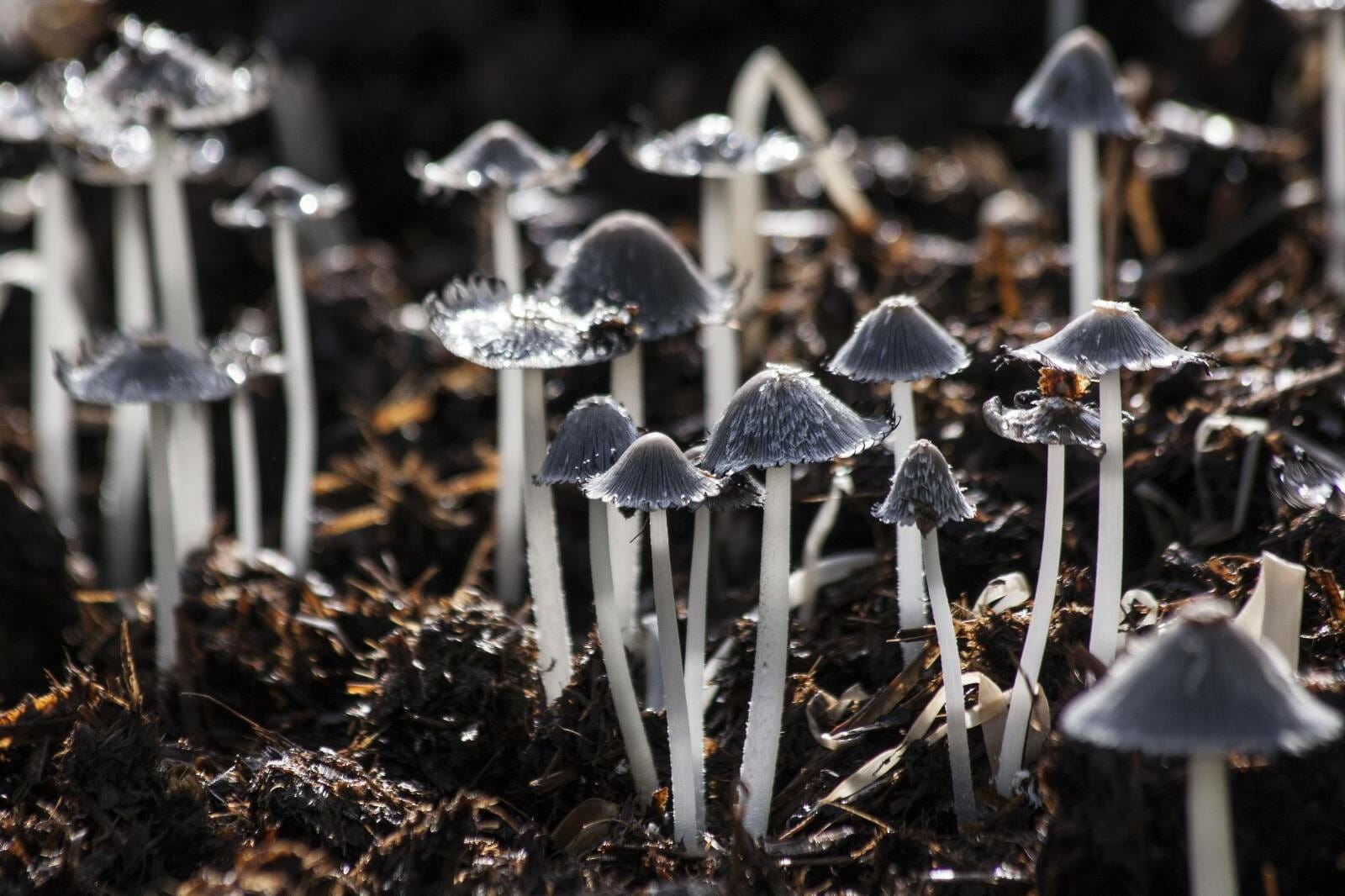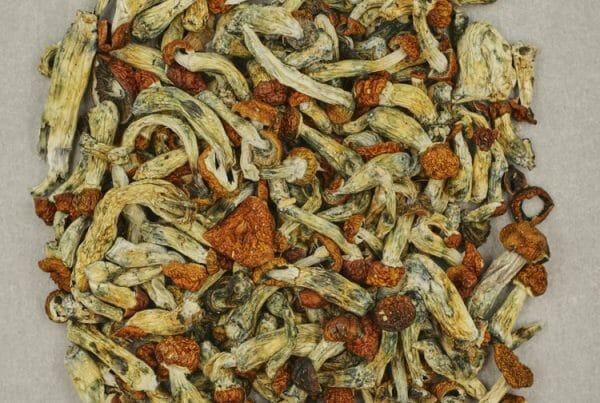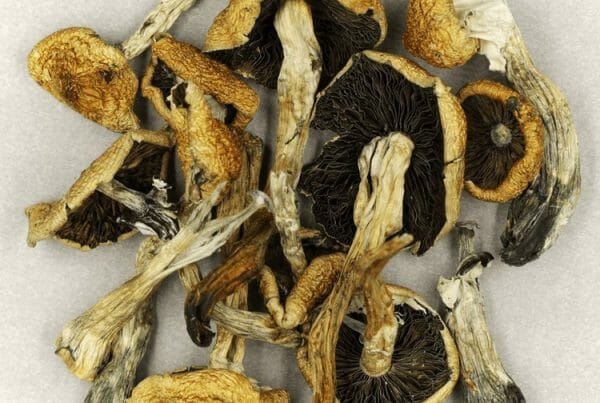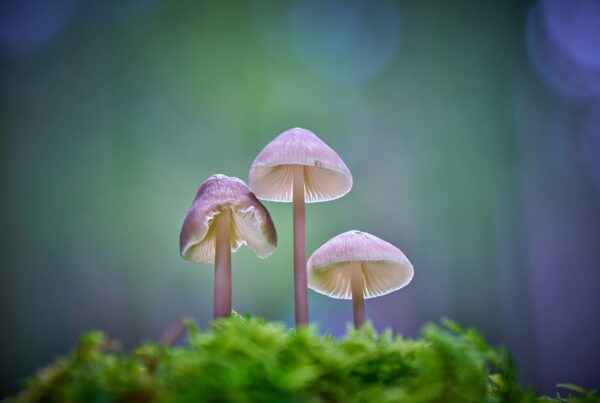The effects of magic mushrooms differ from person to person. Therefore, the onset and duration of the effects also have a wide range of variation. Users can control their dosage intake by knowing how psilocybin, the primary ingredient in hallucinogenic mushrooms, behaves in the body and what variables affect how long its effects last.
Psilocybin users should use the right dosage, as with all other substances, in order to have a positive experience. The last thing anyone wants while consuming magic mushrooms is a negative experience.
This article will discuss psilocybin, how it works, and factors that can affect the duration of its psychedelic effects.
Table of Contents
What are Shrooms?
Shrooms are a particular kind of mushroom that contains the hallucinogenic substance psilocybin. They are often referred to as magic mushrooms, psilocybin mushrooms, or simply shrooms.
Psilocybin has been used for generations to cause hallucinogenic effects, increase consciousness and perception, and elicit euphoric feelings. The usage is widespread among both recreational and medical users.
What is Psilocybin and How It Works
We cannot discuss the effects and anything related to magic mushrooms Canada without discussing psilocybin.
The naturally occurring substance psilocybin, which is present in over 200 kinds of mushrooms, may one day change how we treat depression. This psychedelic compound is structurally identical to serotonin, which controls mood and perception.
Psilocybin is a prodrug which remains inactive until it is consumed and processed by the body. When in the body, it is metabolized to the active compound “psilocin,” which predominantly serves as a partial agonist for the 5-HT2A receptor.
The metabolite psilocin functions as a partial agonist to a lesser extent on 5-HT1A, 5-HT1D, and 5-HT2D receptors, in the basal ganglia, leading to increased dopamine. The complicated mechanism of the compound is said to cause the effects that users experience with psilocybin mushroom.
Serotonin receptors are typically activated by psilocin in the prefrontal cortex. This area influences perception and mood. Additionally, it affects the parts of the brain that control arousal and panic reactions.
It’s not a given that psilocin usually produces vivid or audible hallucinations. Instead, psilocybin alters how certain users see things and people already in their environment.
When Do Effects Start to Kick In?
Psilocybin takes some time to start affecting the body after consumption. According to research, hallucinatory effects can manifest in 20–40 minutes. Most people claim to experience the effects within an hour, while there are occasional exceptions.
These outcomes could develop gradually. With this mushroom species, a person may initially have mild sensory or emotional alterations, followed by increased visual, auditory, or other sensory hallucinations.
How Long Shrooms Last?
On average, a trip lasts between 3 and 6 hours, but some people may feel the effects for much longer. You’re likely to have some after-effects from your trip that could continue into the next day. This is due to elements that can impact how strong and long-lasting the effect can remain. How long do shrooms last? Most people resume feeling like themselves within a day.
Factors Affecting Mushroom Effects on the Body
Food Intake
It is believed that whenever a user consumes Psilocybe on an empty stomach, it will be absorbed more quickly than those who take them with food (or after a meal). It is possible to hypothesize that eating while taking magic mushrooms will alter excretion times. Additionally, the degree of hydration may affect systemic clearance because the primary method through which the active compounds are removed is through urine.
Strain Potency and Dosage
The amount or dosage a person consumes will affect how long shrooms last. The longer it takes to eliminate a substance, the higher the dose a person takes (particularly concerning their body size).
Additionally, some mushroom species are known to be more potent than others, which means they contain a higher amount of psilocybin. It will take longer for the active ingredient to stay in the body if users consume a powerful strain.
Mode of Intake
How you consume magic mushrooms can affect how long psilocybin and its metabolites linger in your system. Dried mushrooms are typically consumed orally by being eaten “as is” or brewed into tea.
Ingesting shrooms “as is” gives a potent and fast experience compared to edibles. The latter can be potent, but it takes time for the effects of psychedelic mushrooms to kick in. Therefore, it lasts longer. Lemon Tek is another method that can speed up the onset, duration and intensity of psilocybin.
Other Factors
If you are still asking “how long do shrooms last?” the effects endure depends on age, general physical and mental health, body weight, use of other substances, and metabolic rate. In general, your shroom trip will be shorter, and psilocybin will leave your body faster if you are younger and have a faster metabolism.
Effects and Benefits
The effects of psilocybin can be divided into psychic and somatic categories, encompassing perceptual, cognitive, emotional, and ego dissolution experiences. The psychic effects of psilocybin include changes in emotions, hypnagogic experiences, altered perception of time, introspection, dreams, illusions, and synesthesia.
The somatic effects are varied and can involve changes in heart rate, reflexes, blood pressure, tremors, nausea, and impaired distance perception during muscular movements (known as dysmetria).
The authors of the review also highlighted some interesting subjective effects of psilocybin in magic mushrooms, including:
- Positive changes in personality and a greater sense of altruism towards society and the environment
- Attenuation of authoritarian views
- Pro-environmental behaviour
- Increased sense of connectedness
- Reduction in suicidal thoughts
- Decreased inclination toward violent or criminal behavior
- Prosocial behaviour
- Reduction of ego and self-centeredness (ego dissolution)
- Openness to new experiences
- Profound personal transformations (referred to as quantum change)
- Enhanced depth during meditation
- Increased overall well-being
Depression
Psychedelic drugs like psilocybin and MDMA have shown potential as therapies for mental health conditions treatment-resistant depression and post-traumatic stress disorder by promoting brain plasticity. The exact mechanisms behind this plasticity have been unclear, but previous studies identified the 5-HT2AR receptor as playing a role.
A research team led by Dr. David Olson from the University of California, Davis, further investigated why certain psychedelic compounds that bind to 5-HT2AR drive plasticity while others do not.
They discovered that compounds able to cross the neuron’s membrane and bind to 5-HT2AR inside the cell induced the growth of dendritic spines, which form connections between neurons. Compounds that could only bind to the receptor on the neuron’s surface did not have the same effect.
These findings provide insights into the receptor’s role in promoting plasticity and could aid in the development of safer drugs without hallucinogenic effects.
Pain
A study demonstrates the use of psychedelic drugs for chronic pain conditions wherein it shows the experiences of three individuals using low-dose psilocybin for chronic neuropathic pain management. Despite variations in pain nature and origin, these patients found significant pain relief and reduced reliance on traditional analgesics through self-administration of psilocybin.
The analgesic effects occurred without inducing a psychedelic experience or significant adverse effects. Additionally, functional exercise seemed to enhance the efficacy and duration of pain relief, and repeated dosing potentially produced long-term plasticity-mediated effects. These findings underscore the therapeutic potential of psilocybin containing mushrooms in treating chronic pain and warrant further investigation.
Migraines
A double-blind, placebo-controlled, crossover study was conducted to investigate the effects of psilocybin on migraines. The study involved 10 adults with migraines who were administered a single dose of oral synthetic psilocybin (0.143mg/kg).
The results showed that psilocybin significantly reduced weekly migraine days compared to the placebo during the following two weeks. Psilocybin treatment also resulted in greater reductions in weekly migraine attacks, pain severity, attack-related functional impairment, and weekly migraine abortive days compared to the placebo. Notably, the study demonstrated that psilocybin was well-tolerated and could provide safe and lasting migraine prophylaxis for up to two weeks after a single administration. Interestingly, the therapeutic effects of psilocybin appeared to be independent of its acute psychotropic effects, suggesting that the therapeutic properties may not rely on the typical perceptual changes associated with psychedelics.
Addiction
This systematic review included four studies (six articles) that examined the use of psilocybin-assisted therapy in patients. The dosage of psilocybin given to the patients ranged from 6 to 40 mg. Three of the studies focused on alcohol use disorder, while one study focused on tobacco use disorder. In a small pilot study with 10 participants, the percentage of heavy drinking days significantly decreased between the initial assessment and weeks 5-12.
Another study with 31 participants found that 32% of them achieved complete abstinence from alcohol, with an average follow-up duration of 6 years. In a larger randomized controlled trial with 95 participants, the percentage of heavy drinking days was significantly lower in the group receiving psilocybin compared to the placebo group during a 32-week period.
Lastly, in a pilot study with 15 participants, 80% reported not smoking for 7 consecutive days at 26 weeks, and 67% reported the same at 52 weeks.
Set and Setting
The environment plays a crucial role in shaping your magic mushrooms psychedelic experience. It’s not just about just consuming shrooms; it’s about how you absorb it. The concept of “set and setting” emerged in the 1950s and gained popularity through influential figures like Al Hubbard, Timothy Leary, and Ram Dass in the 1960s. Let’s explore some ways you can prepare for your psychedelic journey with magic mushrooms.
Preparing Your “Set” or Mindset:
- Clear your schedule: Dedicate uninterrupted time for the experience, free from distractions or stressors. Allow yourself ample time to process afterward as well.
- Set an intention: Define what matters most to you and align your thoughts and choices with that intention. Remember that flexibility is okay if things don’t go as planned.
- Stabilize yourself: Before embarking on the journey, find ways to clear your mind of distractions and achieve a steady state. This might involve meditation, putting away electronic devices, or going for a walk.
- Trust your support system: Having trusted shroom trip sitters, guides, shamans, or therapists can anchor you to a grounded reality. Build a strong rapport with them and rely on their support during the magic mushroom experience and integration afterward.
- Embrace surrender: Let go and surrender to the journey. When taking shrooms, make peace with any anxieties or concerns, and allow the experience to unfold naturally. Sometimes, the most challenging journeys yield valuable insights.
Preparing Your “Setting” or Environment:
- Choose appropriate music: Opt for mellow, instrumental music to create a soothing ambiance. Avoid music with lyrics that may subconsciously influence your thoughts.
- Minimize distractions: Select a location away from distractions like work or household responsibilities. Use an eye mask to block out external stimuli and focus inward.
- Provide options: Create a safe space that offers flexibility. Ensure you can lie down, sit comfortably, access the bathroom, adjust the temperature, or step outside if needed. Having options enhances your comfort and sense of control.
- Align with your intention: Select a setting that aligns with the purpose of your journey. Being close to nature might be ideal if you seek a profound, connected experience. Remember that wherever you are, prioritize your safety.
Why Set and Setting Matter:
Establishing a supportive set and setting greatly influences the quality of your psychedelic trip. By following these tips, you can prepare yourself for an amazing and transformative experience, especially in the context of psychedelic therapy. Preparation is key to avoiding bad trip, maximizing the potential benefits, and ensuring a positive outcome.
Conclusion
The exact explanation for how long do shrooms last in the body or their onset is unclear. There are multiple factors influencing the effects, onset, and experience. The length of a shroom trip can vary depending on the strain, individual metabolism and body, dose, and mode of intake of the psilocybin mushroom, as was already mentioned. The essential thing to consider is always starting at a low dosage and gradually increasing the amount after a few hours to prevent experiencing overwhelming psychedelic trips.
Zoomies Canada offers premium strains and other psilocybin-containing products if you want to try shrooms. You can find one that will suit your needs and give you the experience you have been looking for. With extensive sales and discounts, you can save more when you shop from us!
Related Articles:





